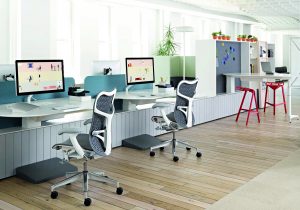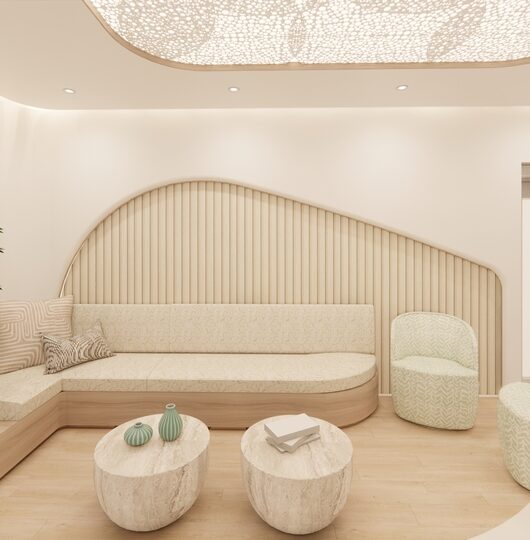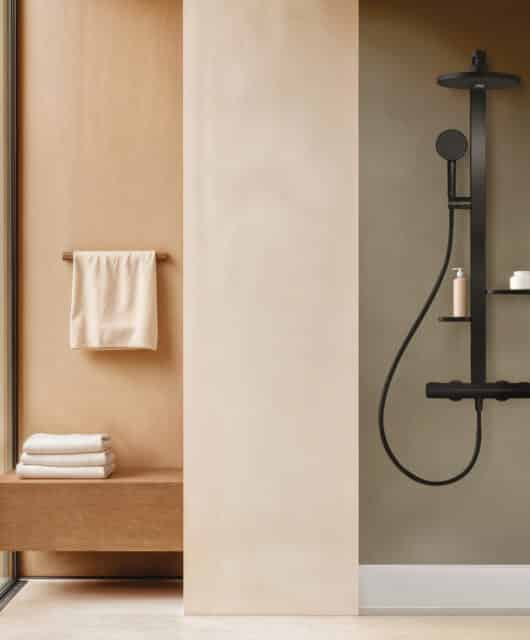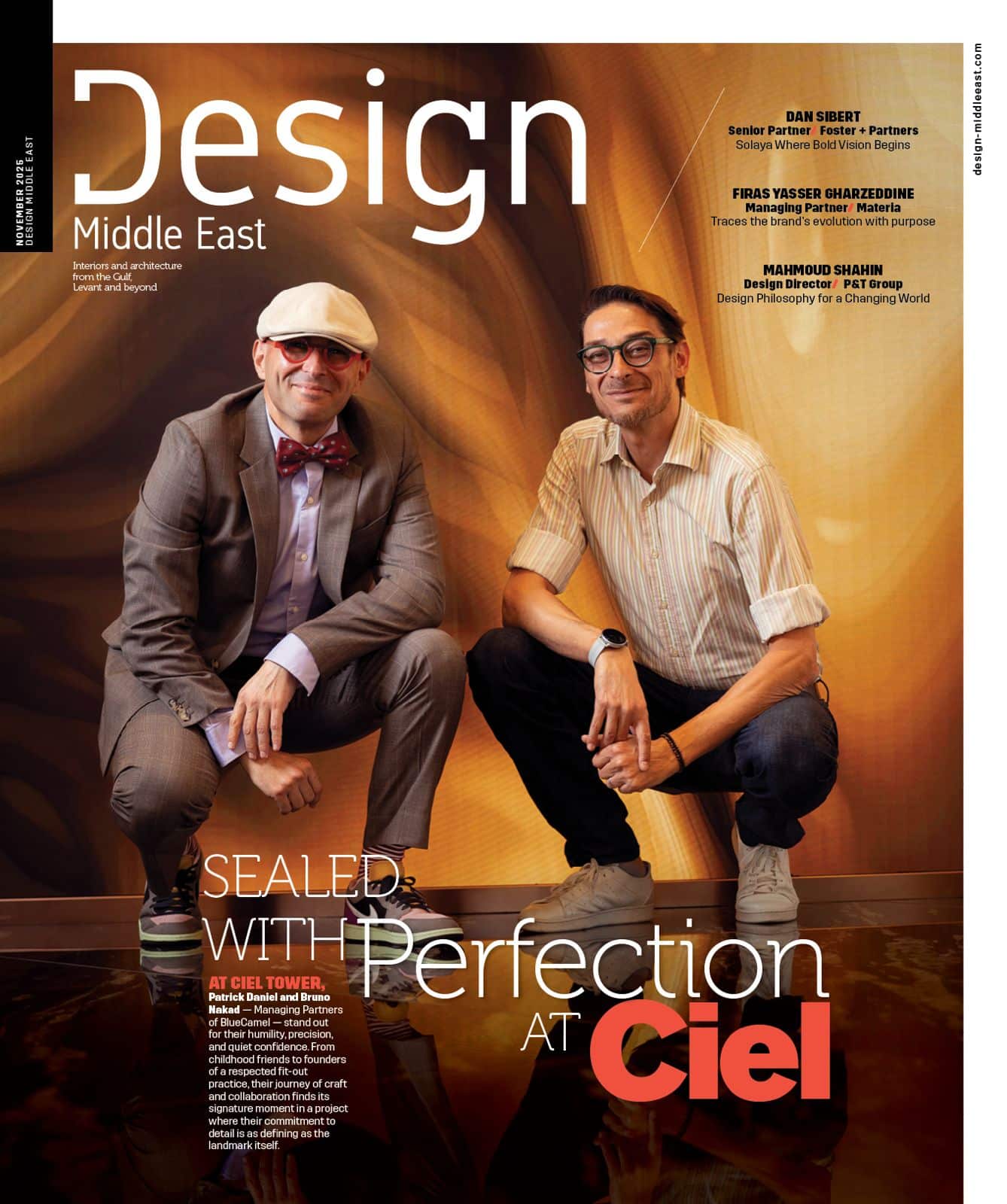It sounds obvious to say no one really likes being in the office, but there’s more to that idea than simply feeling a bit work-shy. In May this year, the Middle East Council of Offices (MECO) and the Royal Institution of Chartered Surveyors (RICS) released a report on the connection between office environments and productivity in the region. Among some of the startling headline figures was the fact that 67 per cent of those surveyed reported at least one factor that had a negative impact on their
productivity. There were plenty to choose from. A lack of flexibility was cited by more than 75 per cent of respondents, and noise and interruptions in open-plan offices were a problem for 40 per cent and 51 per cent respectively; a further 34 per cent suggested that a lack of quiet areas was detrimental. Throw in the 38 per cent who complained about waiting for lifts and there was little to cheer about.
“It was thought that if you change from what we call a cellular office environment, where everybody has their own individual office to an open-plan environment, that will be an optimum solution and we now know that it is actually far from that,” says Chris Seymour, regional development director at Mott MacDonald and co-chair of the Middle East Council for Offices.
“The reason for that is that people who are in the open-plan space continually get distracted by noise, movement of their coworkers, and other aspects. In particular this does not suit the introverts at all and companies need introverts, they’re the ones who are creative.”
Activity hubs
Dig down into the research and there were other interesting findings. For instance, Generation Y employees said an activity-based workspace was their preferred office layout and, importantly, folks outside that age group don’t mind it either.
“Now, activity-based working is not where you have a fixed desk in open-plan. It actually means you don’t have that – the office is laid out in a manner that relates to the activity being undertaken,” explains Seymour, who also sits on the market advisory panel for RICS.
“That activity might be collaborative, it might be creative or it might be one of learning. The theory is that you move around areas of the office depending on what you’re doing. This suits Gen Y, an increasing number of people in our workforce, making them more productive.”
But it’s not enough to simply change the office layout. In order to achieve a design that keeps people productive, the basics have to be right – doing everything possible to create a comfortable environment. That means taking care of what some call ‘hygiene factors’ – things people only notice when they aren’t there, such as safety, security, a pleasant temperature and lifts that don’t keep them waiting all day.
“This isn’t necessarily a MENA-specific problem,” says Salim Hussain, principal architect with Atkins. “If you look at a lot of the research done in the US or Europe, you find people have issues with older buildings where they can’t control the temperature or newer ones where staff say they don’t like open-plan.
“The issue is not that the Middle East designs bad offices, it is the complexity of the work environment and the complexity of human beings. You can plan in a floor plate and say ‘Here, this is your workspace’, but this has a lot of nuances. We’re starting to understand those nuances now and are responding to them more.”
Comfort zone
In theory, responsive office designs make people happier and happiness in turn leads to greater productivity. Designing an office space that is responsive to its occupants could involve anything from providing a dedicated space for certain activities – be they meetings, phone calls or conference sessions – or fine turning the environment to meet individuals’ needs within reasonable boundaries that also work for everyone else. If people don’t feel comfortable physically, that could well affect them psychologically too.
“A desk is not appropriate for quite a lot of the activities we’re doing today. We need choice and also a variety of spaces in which to work hand in hand, so people feel their needs are catered for” – Oliver Baxter
“Temperature, for example, is something you can give people control over, but the challenge with that in an open-plan office is that you have different people who want the air conditioning on or off,” says Hussain. “At the same time you can be a little more subtle. Temperature might be set [centrally], but if people have windows they can open, they have a level of control over their space.
“Humans are complex – you don’t come in and switch on for eight to 10 hours. You have periods where you slow down or you speed up. Your environment needs to address this.” Taking a broader outlook helped some companies develop facilities in which work can take place anywhere, inside or out. Hussain cites the likes of Google and Apple as organisations in which the workspace is not a single element such as a desk but the whole environment. “There is a trend to move from cellular to open-plan, but for me it’s a question of really understanding how we function and then responding to that,” says Hussain.
“The trend for me is not to say ‘Is it open or closed plan?’, it’s actually to respond to human needs. That doesn’t mean to say that open plan is necessarily the better solution for your particular environment. Make it responsive to what the user needs to give them an environment in which they can be productive.”
Corporate culture
Getting the environment right is one part of a puzzle that also includes the culture of the company occupying the space. This has to be included in any assessment of which office spaces will work well and to help create an appropriately productive environment.
Oliver Baxter, Insight Programme manager for Herman Miller, says: “You can create a really lovely lounge setting where people can engage in collaborative work or creative thought, but if the culture of the company means it’ll be viewed as a place where people slack off, it is never going to work. We try to educate, and in the first brief with the client elevate their knowledge, so that when spaces are provided they are appropriate for that client and the people within them know how to use them.”
Baxter adds one of the key points is to give people the autonomy to choose where, when and how they want to work within a space. Designers must also recognise that work no longer just happens at desks.
“A desk is not appropriate for quite a lot of the activities we do today,” he says. “We need choice, and also a variety of spaces in which to work hand in hand so people feel their needs are catered for.”
These changes are driven by a shift from old-fashioned process work to the information gathering roles of the modern knowledge economy. One of the challenges this throws up is how to measure productivity – something once easily measured by counting units made is now far harder to quantify.
“We see the impact of bad design globally,” says Baxter. “There is a variety of ways you can infer that bad design is at play. One of the predominant ways is to look at productivity, but it is hard to measure; engagement is easier. I like quoting Gallup, which highlighted in 2013 that 71 per cent of people worldwide were not engaged with their work. In the UAE that same year, the figure was 74 per cent. For me, some of that is down to poor design, some of it poor culture and some, poor technology as well.”
Herman Miller has put considerable research effort in to finding ways to improve the office, including going so far as taking blood tests from sample groups trialling different office settings in an effort to determine the subjects’ levels of stress and trust. This depth of research has influenced the company’s approach to office design and its shift towards an activity based working model. Baxter suggests these ideas give the region a chance to skip the pain of transitioning from cellular offices to open-plan workspaces – instead, they can head towards a more considered, activity-based model.
“What we champion is more tailored to individual needs,” Baxter says. “We can skip a step and jump forwards. Speaking to clients in the region, there are some very forward thinking organisations willing to skip that step and start to understand individual needs.”
It’s a view supported by the RICS research, which found that the propensity to experiment with the idea of activity-based workspaces was stronger in the Middle East than in other places. The researchers concluded from this that designers in the region should be prepared to take more risks, be bold and experiment with activity-based working because the environment is not as conservative as it may first appear. If they do, the findings could result in a better and more productive work life for everyone.
“Humans are complex – you don’t come in and switch on for eight to 10 hours. You have periods where you slow down, times when you speed Your environment needs to address those” Salim Hussain









